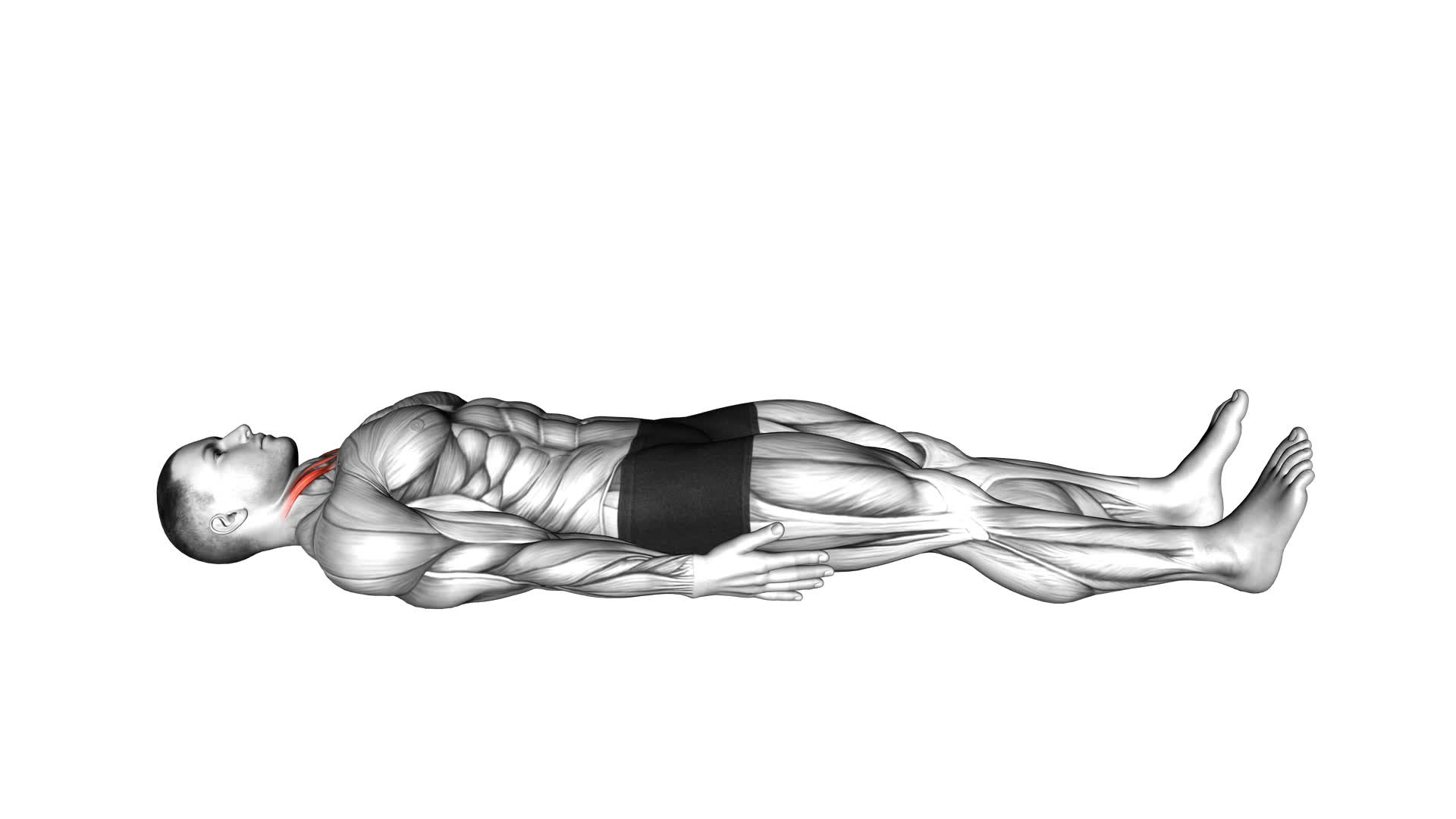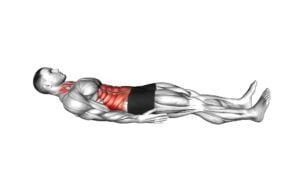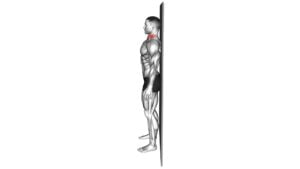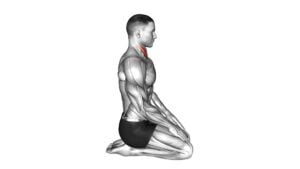Lying Chin Tucks – Video Exercise Guide & Tips

Looking to improve your posture and strengthen your neck muscles? Check out this video exercise guide for lying chin tucks.
Watch This Exercise Video
In just a few minutes a day, you can reap the benefits of this simple yet effective exercise. Learn the proper technique and avoid common mistakes to maximize your results.
With the help of this guide, you'll be on your way to better posture and a stronger neck in no time.
So grab a mat and get ready to start.
Key Takeaways
- Lying chin tucks can improve posture and alleviate neck and shoulder pain.
- Proper technique includes gently nodding the chin towards the chest and engaging the core.
- Common mistakes to avoid include rushing the movement, overarching the lower back, and straining the neck.
- Equipment such as an exercise mat, towel or foam roller, mirror, and resistance band can enhance the exercise.
The Benefits of Lying Chin Tucks
You can experience several benefits from incorporating lying chin tucks into your exercise routine. Lying chin tucks are a simple yet effective exercise that can help improve your posture and alleviate neck and shoulder pain. By gently tucking your chin in towards your chest while lying on your back, you engage the muscles in your neck and upper back, which can help strengthen and tone them over time.
One of the key benefits of lying chin tucks is that they can help correct forward head posture, a common problem caused by spending long hours hunched over desks or electronic devices. By regularly incorporating this exercise into your routine, you can gradually improve your posture and reduce the strain on your neck and shoulders.
Another benefit of lying chin tucks is that they can be easily modified to suit your fitness level and specific needs. You can perform them on a mat or a stability ball to increase the difficulty and engage your core muscles as well. Additionally, you can incorporate variations such as holding the tuck for a few seconds or performing them in a seated position for added challenge.
Now that you know the benefits of lying chin tucks, let's move on to discussing the proper technique for performing this exercise.
Proper Technique for Lying Chin Tucks
To perform lying chin tucks correctly, start by lying on your back with your knees bent and feet flat on the floor. Here are some tips to ensure proper technique for lying chin tucks:
- Position your head: Gently nod your chin towards your chest, keeping your neck relaxed.
- Engage your core: Draw your belly button towards your spine to stabilize your torso.
- Maintain a neutral spine: Avoid arching your lower back by pressing it into the floor.
- Breathe naturally: Inhale deeply through your nose and exhale through your mouth during the exercise.
It's important to be aware of common errors and modifications when performing lying chin tucks. Some common errors include:
- Straining the neck: Avoid pulling or forcing your head down, as this can strain your neck muscles.
- Overarching the lower back: Keep your lower back in contact with the floor to prevent excessive arching.
- Holding your breath: Remember to breathe naturally throughout the exercise to maintain proper form.
- Rushing the movement: Take your time and perform the chin tucks slowly and controlled for maximum benefit.
If you have any neck or spine issues, it's recommended to consult with a healthcare professional before attempting this exercise. Additionally, you can modify the exercise by using a towel roll to support your cervical spine and provide additional comfort.
Common Mistakes to Avoid
One common mistake to avoid when performing lying chin tucks is rushing the movement, as it can compromise the effectiveness of the exercise. Preventing injuries and maximizing results require proper execution, so it's important to focus on the quality of each repetition rather than the quantity. Rushing through the movement can lead to poor form and a lack of engagement in the targeted muscles. Remember to take your time and perform the exercise with control.
Another common mistake to avoid isn't maintaining proper alignment. Ensure that your head, neck, and shoulders are in a neutral position throughout the exercise. Avoid excessive tilting or flexing of the neck, as this can strain the muscles and potentially lead to injuries.
Additionally, it's crucial to avoid using momentum to perform the chin tucks. Momentum can take away from the effectiveness of the exercise and increase the risk of injury. Instead, focus on using the muscles in your neck and upper back to initiate the movement.
Equipment Needed for Lying Chin Tucks
To properly perform lying chin tucks and maximize your results, it's important to have the necessary equipment. Here are four items you'll need:
- Exercise mat: A comfortable and supportive mat will provide cushioning for your body while performing lying chin tucks. It will also prevent any discomfort or strain on your back or neck.
- Towel or foam roller: Placing a towel or foam roller under your neck will help to maintain proper alignment and support during the exercise. This will prevent any unnecessary strain on your neck and ensure that you're targeting the correct muscles.
- Mirror: Having a mirror nearby while performing lying chin tucks is essential for proper form and technique. It allows you to visually check your chin position and ensure that you're correctly tucking your chin without any tilting or rotation.
- Resistance band: As you progress with lying chin tucks, you may want to add resistance to increase the challenge. Using a resistance band can help to strengthen the muscles involved in the exercise and further improve your posture.
Tips for Getting the Most Out of Lying Chin Tucks
To get the most out of your lying chin tucks, it's important to focus on proper form techniques. Keep your spine aligned and engage your core throughout the exercise.
Additionally, be mindful of common mistakes such as straining your neck or using excessive force. Following these tips will help you maximize the effectiveness of your lying chin tucks and prevent any potential injuries.
Proper Form Techniques
Maximize the effectiveness of your lying chin tucks by focusing on proper form techniques. To ensure you're performing this exercise correctly, follow these tips:
- Keep your spine aligned: Maintain a neutral spine position throughout the exercise, avoiding any excessive arching or rounding of the back.
- Engage your core: Activate your abdominal muscles by gently drawing your belly button towards your spine. This will help stabilize your body and promote proper posture.
- Practice proper breathing techniques: Inhale deeply through your nose before starting the movement and exhale slowly through your mouth as you tuck your chin towards your chest. This will enhance muscle activation and oxygen flow.
- Avoid straining your neck: Be mindful not to forcefully tuck your chin or strain your neck muscles. Perform the movement in a controlled and comfortable manner.
Preventing Common Mistakes
To prevent common mistakes and get the most out of lying chin tucks, focus on these tips for proper form and technique.
Firstly, it's crucial to avoid straining your neck or back. Make sure you're lying on a comfortable surface, such as a mat or a towel, to prevent injuries.
Secondly, always remember to engage your core muscles throughout the exercise. This won't only enhance the effectiveness of the chin tucks but also help in improving posture.
Additionally, be mindful of your breathing. Inhale deeply and exhale as you tuck in your chin.
Lastly, start with gentle movements and gradually increase the intensity as your muscles become stronger.
Progression and Variations of Lying Chin Tucks
Now that you've mastered the basic lying chin tucks, it's time to take your workout to the next level with advanced chin tucks.
These variations involve adding resistance or incorporating different lying positions to target specific muscles in your neck and upper back.
Advanced Chin Tucks
Take your lying chin tucks to the next level by incorporating advanced variations and progressions. Here are some advanced techniques you can try:
- Weighted Chin Tucks: Hold a small weight, such as a dumbbell or a weighted ball, against your chin while performing the chin tuck. This added resistance helps to strengthen the muscles even more.
- Elevated Chin Tucks: Place your head on an elevated surface, such as a yoga block or a foam roller, and perform the chin tucks. This increases the range of motion and challenges your muscles in a different way.
- Dynamic Chin Tucks: Instead of holding the chin tuck position, move your head up and down in a controlled manner. This dynamic movement increases the difficulty and engages the muscles more effectively.
- Single-Leg Chin Tucks: Lift one leg off the ground while performing the chin tucks. This challenges your balance and core stability, adding an extra element to the exercise.
By incorporating these advanced variations, you can continue to progress and challenge your muscles.
Now, let's move on to different lying positions.
Different Lying Positions
As you progress in your lying chin tucks, you can explore different lying positions to further challenge and engage your muscles. By varying your lying position, you can target different muscles and improve your overall strength and stability.
One variation you can try is the side-lying chin tuck. Lie on your side with your head supported by your arm and perform the chin tuck motion. This position not only works your neck muscles but also engages your core and shoulder muscles for added stability.
Another option is the supine chin tuck. Lie on your back with your knees bent, and perform the chin tuck while keeping your feet flat on the ground. This position allows for better alignment of your spine and targets the muscles in the front of your neck.
Remember to maintain proper form techniques in all lying positions to maximize the benefits and prevent injuries.
Frequently Asked Questions
Can Lying Chin Tucks Help Improve Posture?
Lying chin tucks are a great exercise for improving neck alignment and posture. By performing this exercise, you can strengthen the muscles in your neck and upper back, which helps to pull your head back into proper alignment.
This can lead to better posture overall and may help alleviate any discomfort or pain caused by poor posture. So, incorporating lying chin tucks into your routine can have numerous benefits for your posture and overall well-being.
How Often Should I Perform Lying Chin Tucks to See Results?
To see results and improve neck flexibility, it's important to perform lying chin tucks regularly. By incorporating this exercise into your routine, you can reap the benefits of proper neck alignment.
Consistency is key, so aim to do lying chin tucks at least a few times a week. Remember to always listen to your body and start with a comfortable range of motion.
Over time, you'll notice improvements in your posture and overall neck health.
Are There Any Specific Precautions or Contraindications for Performing Lying Chin Tucks?
Before attempting lying chin tucks, it's important to be aware of any precautions or contraindications. These exercises may not be suitable for everyone, especially if you have any pre-existing neck or spine injuries. It's always a good idea to consult with a healthcare professional before starting any new exercise regimen.
They can provide personalized advice and ensure that you perform the exercise safely and effectively. Take care of your body and prioritize your safety.
Can Lying Chin Tucks Help Reduce Neck Pain or Stiffness?
Lying chin tucks can be a helpful exercise for reducing neck pain or stiffness. By gently tucking your chin towards your chest while lying down, you can stretch and strengthen the muscles in your neck.
This can lead to improved neck health and a decrease in discomfort. Lying chin tucks offer benefits such as increased flexibility and improved posture.
Incorporating this exercise into your routine can be a simple and effective way to find relief for neck pain.
Are There Any Modifications or Adaptations for Individuals With Limited Mobility or Injuries?
If you have limited mobility or injuries, there are modifications and adaptations you can make for lying chin tucks. These modifications can help you perform the exercise safely and effectively.
Additionally, there are alternative exercises for lying chin tucks that you can try if the traditional exercise isn't suitable for your situation.
It's important to consult with a healthcare professional or a qualified exercise specialist to determine the best modifications or alternative exercises for your specific needs.
Conclusion
In conclusion, lying chin tucks are a beneficial exercise for improving neck and upper back strength and flexibility. By following the proper technique and avoiding common mistakes, you can effectively target the muscles involved in maintaining good posture.
Minimal equipment is needed, making this exercise accessible for most individuals. By incorporating variations and progressing over time, you can continue to challenge your muscles and see continued improvements in your posture and overall neck and upper back health.

Author
Years ago, the spark of my life’s passion ignited in my mind the moment I stepped into the local gym for the first time. The inaugural bead of perspiration, the initial endeavor, the very first surge of endorphins, and a sense of pride that washed over me post-workout marked the beginning of my deep-seated interest in strength sports, fitness, and sports nutrition. This very curiosity blossomed rapidly into a profound fascination, propelling me to earn a Master’s degree in Physical Education from the Academy of Physical Education in Krakow, followed by a Sports Manager diploma from the Jagiellonian University. My journey of growth led me to gain more specialized qualifications, such as being a certified personal trainer with a focus on sports dietetics, a lifeguard, and an instructor for wellness and corrective gymnastics. Theoretical knowledge paired seamlessly with practical experience, reinforcing my belief that the transformation of individuals under my guidance was also a reflection of my personal growth. This belief holds true even today. Each day, I strive to push the boundaries and explore new realms. These realms gently elevate me to greater heights. The unique combination of passion for my field and the continuous quest for growth fuels my drive to break new ground.







